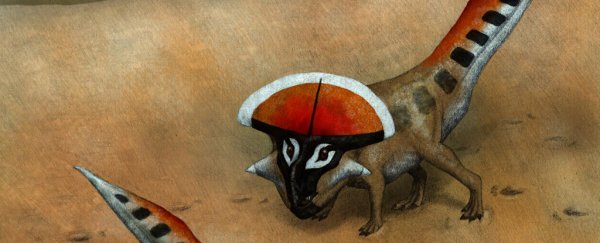This article was written by Rob Knell from Queen Mary University of London, and was originally published by The Conversation.
Part of dinosaurs' popularity has to be their fascinating, bizarre appearance. There's the Stegosaurus with the famous row of plates down its back, the Triceratops with its giant frilled skull, and the 'duck-billed' hadrosaurs with their peculiar and diverse array of crests.
Palaeontologists have been trying to decipher the function of these extravagant traits for many years. The Stegosaurus plates have been described as a way to regulate body temperature and it's even been suggested that the hadrosaur crest might have been a kind of snorkel.
More recently, it has become increasingly popular to see these kind of features in the same way as the enlarged fins of male Siamese fighting fish or the plumes of birds of paradise. These are best explained as traits that evolved not because they improve survival but because they improve the mating success of the bearer. My colleagues and I at Queen Mary University of London have now found what we believe to be some of the best evidence of unusual dinosaur features that were primarily used in this way.
Sexual selection
'Sexual selection' explains how animals can evolve features that may even reduce the bearer's survival. For example, some male birds such as widowbirds or pheasants have extraordinarily long tail feathers that require a lot of protein to grow and reduce the male bird's ability to fly. Because the females of these species choose the males with the longest tails to father their chicks, those males have the highest evolutionary fitness despite being effectively handicapped by their ornaments.
We now know that sexual selection is the driving force behind the great majority of the extravagant, ornamental and showy traits that we find in the animal kingdom. This has led more and more palaeontologists to ask whether sexual selection might also be behind the apparently ornamental traits that we find in many extinct species.
The problem is that it's extremely difficult to tell if a particular feature of an extinct, prehistoric animal gave it an advantage in the mating game. What's more, there are examples of apparently pointless features of animals that have turned out to have had 'normal' functional roles, such as the protruding snouts of paddlefish used as sensory organs. If we just decide that anything that seems a bit strange and inexplicable on a dinosaur fossil must have arisen by sexual selection, we run the risk of misinterpreting odd-looking but functional traits in these ancient animals, and palaeontologists have avoided using sexual selection as an explanation for the evolution of extravagant traits for this reason.
One thing we can do to try to work out if a feature has evolved through sexual selection is study its size compared to the rest of the animal's body. When something gets proportionally bigger as an animal gets bigger we say that it has positive allometry. Although it's by no means a universal rule, there seems to be a strong tendency for sexually selected traits, especially those that function as signals for attracting females or intimidating rivals, to be positively allometric. Positive allometry is also quite rare among traits that are not sexually selected.
Measuring the allometry of these extravagant traits in dinosaurs isn't possible for many species because most extinct animals are only known from one or a few fossils. Complete specimens of dinosaurs are the exception and it's difficult to even tell males from females. One of the few species we have decent numbers of specimens of is the dinosaur Protoceratops andrewsi. This smaller relative of the famous Triceratops had a skull that elongated into a large frill.
My colleagues and I were able to put together a set of 37 Protoceratops fossils ranging in size from tiny juveniles up to the largest adults. By measuring the specimens' skulls, we found that bigger Protoceratops had proportionally longer and wider frills – positive allometry. What's more, larger animals seemed to have frills that spread more widely around the head whereas those of smaller animals were almost flat against the neck.
Colourful animals
This information strongly supports the idea that the frills of these animals, and by extension those of other related dinosaurs, were primarily a signal for other members of their species. Most likely they were associated with mating, although we can't rule out other functions such as establishing social hierarchies (the bigger the frill, the more important the dinosaur in the group).
Dinosaurs are often reconstructed as plodding, grey giants. If we start to think about them as active animals with complex social lives then perhaps we should move away from this picture. If these frills were primarily used as signals, maybe they were as colourful as similar traits found on modern birds.
Protoceratops had several other unusual traits that might also have been involved in signalling and either attracting mates or establishing social position. They had some surprisingly long teeth and their tail vertebrae have long processes on the top, meaning that they were high and probably conspicuous. Considering these features, we can start to imagine these dinosaurs as social, active and brightly coloured rather than the dull plodders that we are used to thinking about.
![]() Rob Knell, Senior Lecturer, Queen Mary University of London
Rob Knell, Senior Lecturer, Queen Mary University of London
This article was originally published by The Conversation. Read the original article.
